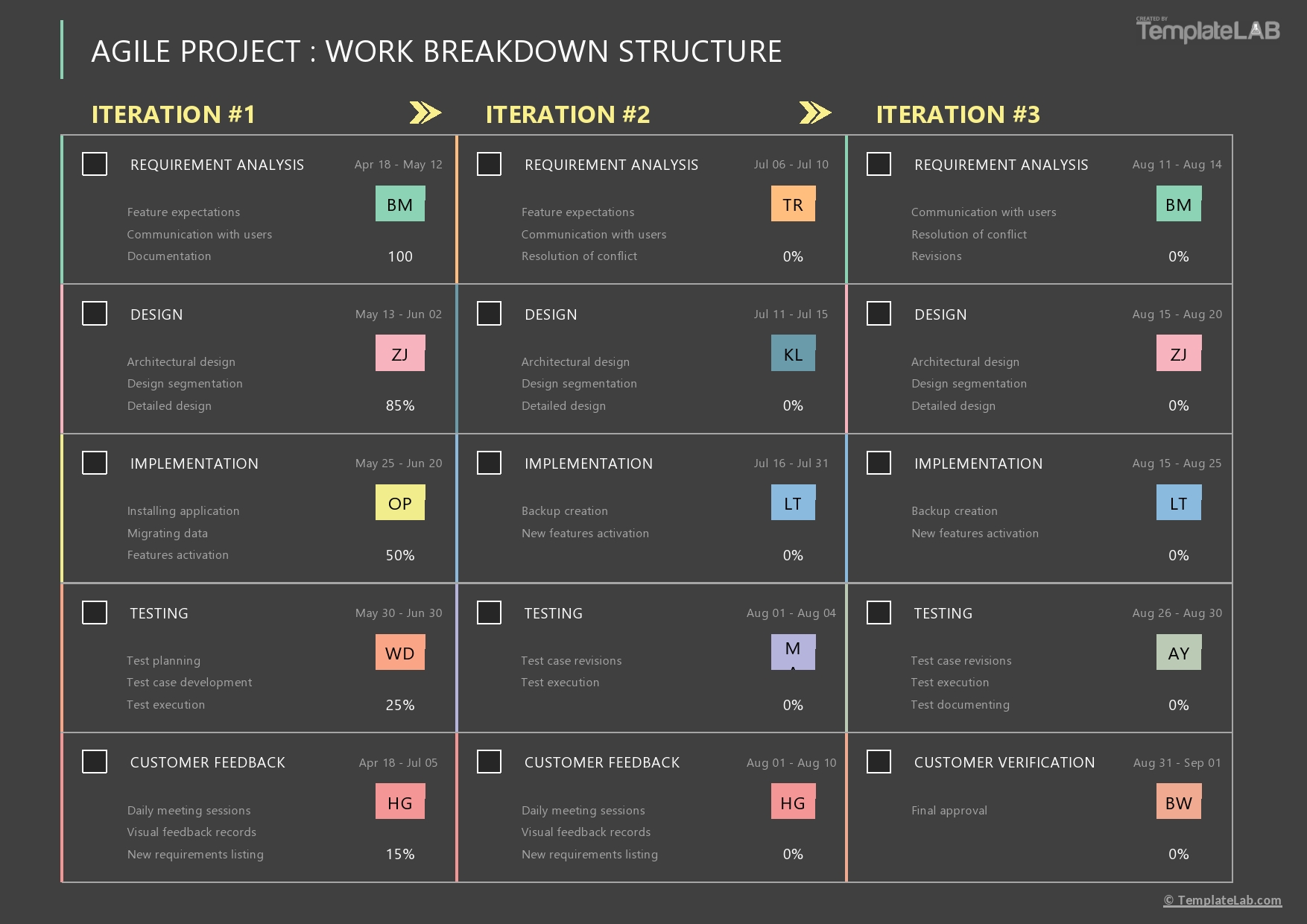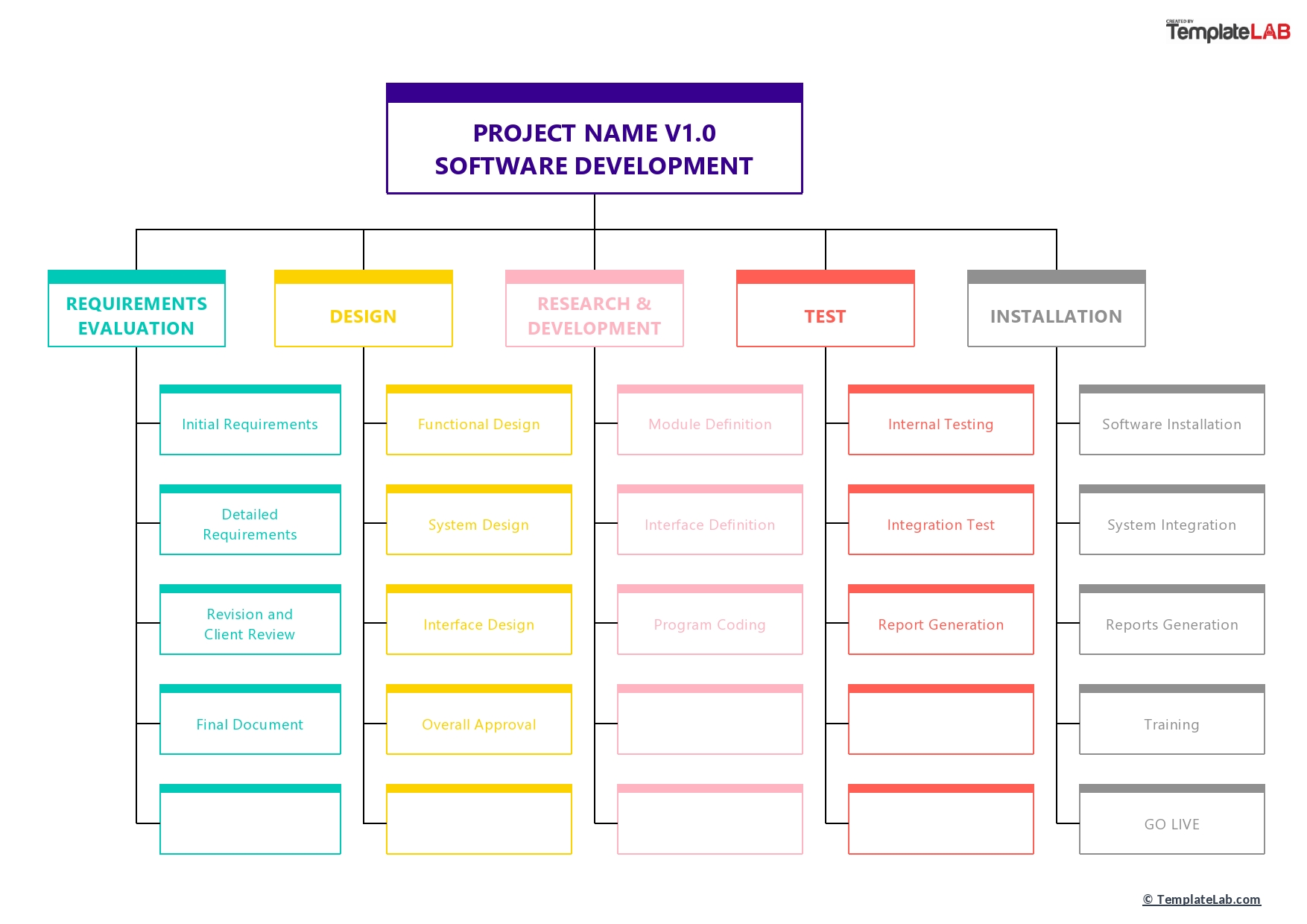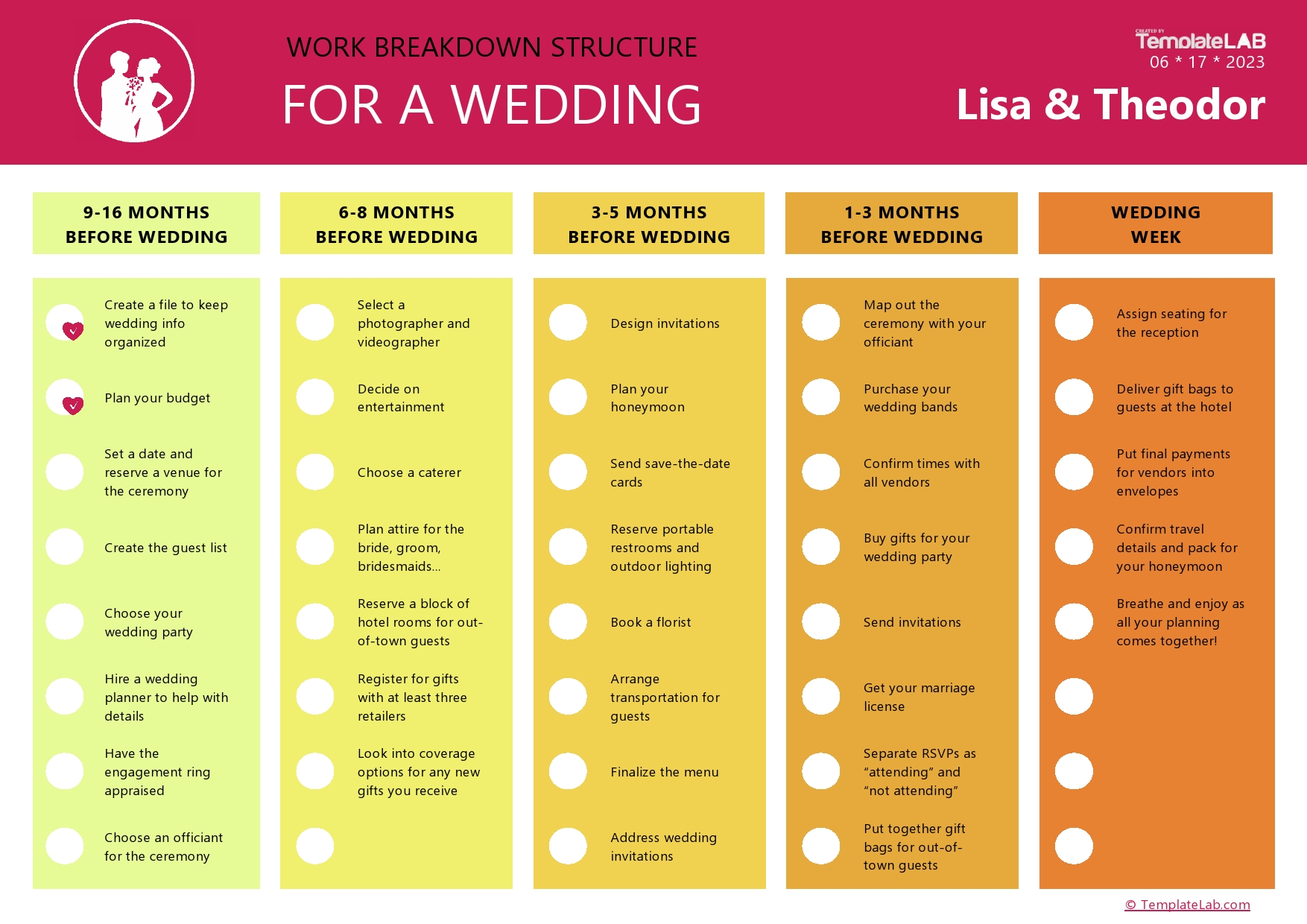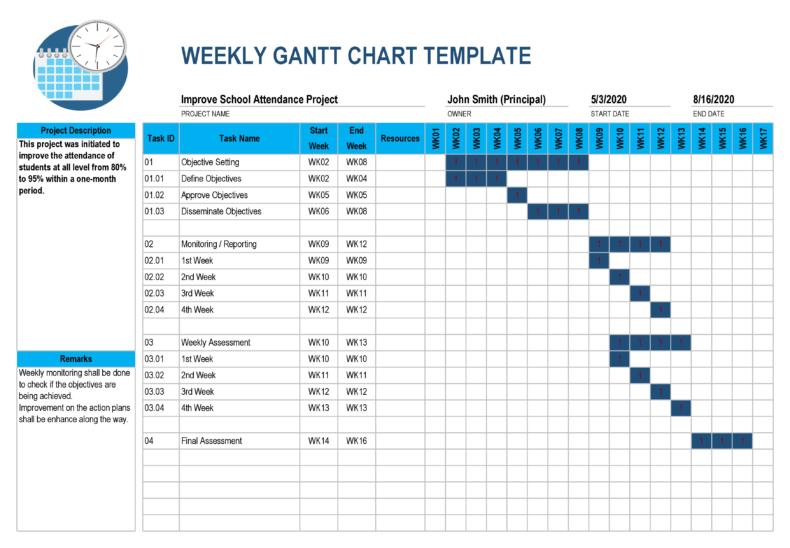A work breakdown structure template is a management tool that visualizes a project breakdown. This tool takes a step-by-step approach to the completion of big projects with several moving parts.
A WBS can combine scope, cost, and deliverables into one tool by dividing the project into smaller parts. A work breakdown structure can be made using project management frameworks and workflow management software.
Table of Contents
- 1 Work Breakdown Structures Templates
- 2 What is a Work Breakdown Structure?
- 3 What Are The Two Types of a Project Manager’s WBS?
- 4 Work Breakdown Structures Examples
- 5 What Are the 4 Levels of a Work Breakdown Structure?
- 6 What does a Work Breakdown Structure Contain?
- 7 WBS Keywords
- 8 When Is a Work Breakdown Structure Necessary?
- 9 How To Create a Work Breakdown Structure Template
- 10 Conclusion
In this article, we’ll go through how to create a work breakdown structure, what to include, and examples of how to use it in your day-to-day projects.
Work Breakdown Structures Templates
What is a Work Breakdown Structure?
A WBS is a visual chain of command and deliverable-orientated deconstruction of a project. They are most commonly used by project managers, allowing them to break down their project scope into smaller, achievable chunks. This helps visualize all the tasks that need to be completed to finish their project.
Work breakdown structures have descending levels that represent increasingly detailed definitions of the work that needs to be completed. These structures are decomposed into work packages and include internal and external deliverables.
What Are The Two Types of a Project Manager’s WBS?
- Deliverable-based – This is a hierarchical split of the work that is based on deliverables. This means examining the overall project scope and dividing the workload into deliverables that support it. This method works especially well for projects with a limited duration and a clear goal. Creating an annual revenue report is one example.
- Phase-based – Work packages that contain groups of tasks are created using project phases in the phase-based WBS. Then, these task groups are finished gradually. A phase-based WBS should be used for lengthier projects with ambiguous goals. For instance, over the following three years, you intend to increase retention by 20%.
Work Breakdown Structures Examples
What Are the 4 Levels of a Work Breakdown Structure?
A work breakdown structure’s levels assist in classifying jobs according to dependencies. Because projects can vary so widely, your job breakdown structure’s levels will too. You might come across projects that don’t need sub-dependencies, even if the majority of projects do have some kind of dependencies.
Let’s look at the top four level dependencies within a work breakdown structure.
- Level 1: The Primary Goal
Given that it contains the primary goal, the first level of your work breakdown structure is the project’s most streamlined configuration. Typically, this corresponds to the project objective.
Consider a scenario when your project team is revising the layout of your website. Your WBS’s initial level can resemble the following:
‘Create and launch a brand-new website’. - Level 2: Tasks and Dependencies
Level 2 outlines the main phases of a project and the key deliverables that need to be achieved. It can also include the major parts, systems, or features that need to be delivered in the final project to meet the customer’s expectations.
Depending on the size of the project, your breakdown structure will then become a little more complex. Subtasks, also known as dependencies of level 1, will be included in level two of your WBS.
Let’s take the tasks necessary to introduce a new website design as an example.
Carry out competitor research.
Organize a session of innovative brainstorming.
Update brand standards.
Build a new website infrastructure.
Redesign your logo and create new images.
Level two provides a high-level overview of the dependencies required to fulfill the project’s goal and is a little more detailed than level one. - Level 3: Smaller Tasks
The tasks from level 2 are now divided into smaller, easier-to-manage tasks. Teams must first complete the tasks outlined in the tasks and dependencies level to be successful at the smaller tasks level.
To subdivide these tasks into more manageable parts, a project manager should describe the most specific tasks at this point in the project lifecycle. The road to completing all of your essential deliverables will be made easier by these doable activities.
Using the aforementioned example as a guide, the level three tasks for creating a new website are as follows:
Select brand colors.
Construct a brand mood board.
Create new software development structures.
Designate UX specialists.
Build a design mockup.
Examine and accept mockups.
Plan a marketing picture shoot.
Image resize and edit.
As you can see, it is becoming increasingly clearer what needs to be done to achieve the project’s purpose. Depending on how your WBS template performs, you might even decide to add additional levels depending on how specific you want your visual to be. - Level 4: Assess Status
Level 4 is usually the final stage of the WBS. It includes an assessment of the completion of levels 1 through 3. Level 4 consists of methods to test the completeness of the entire project.
Using a new website as an example, one of the level 4’s WBS points would be to test the website launch and its potential success. Testing for completeness in the WBS is one of the most crucial parts of running a successful project.
What does a Work Breakdown Structure Contain?
You must first be aware of the components of a breakdown structure before you can design your own. Fortunately, we have you covered. Let’s look at some of the important components you should have in your job work breakdown structure.
- WBS keywords
- Mission statement
- Task managers
- Task Budget
- Date of completion
- Task status
WBS Keywords
When creating a new project structure, familiarizing yourself with some project keywords is an excellent place to start. A good WBS template doesn’t include lengthy explanations, so having a few keywords is instrumental in helping project team members fulfill their tasks.
Include the following keywords in your WBS:
- Acceptance Criteria: Otherwise known as the “definition of done”. This specifies the requirements and scope that must be completed by developers before the user narrative is deemed complete. The creation of acceptance criteria for the stories in your product backlog may fall under you as a product manager or product owner.
- Budget: A budget is an estimate of income and expenses for a given period that is created and reviewed regularly. It is the anticipated costs involved with complex projects, which can be divided into a project phase or deliverable.
- Deliverables: These are the quantifiable items or services that must be offered at different project stages as well as at the end of the project. Deliverables make it possible to allocate resources wisely and keep the project schedule on track.
They are essential to a company’s performance because they keep managers on track. For example, a deliverable-based WBS template for a website design project would be organized around deliverables such as the URL, layout, and textual content. - Milestones: When there are milestones, it is simple to identify attainable milestones within the project timetable or timeline. Focus on developing specific scheduling plans for each of these milestones, and work toward achieving them.
By completing each phase and mini-target one step at a time, you meet your project objectives and scheduling requirements. - Phases: A project’s numerous stages. For example, a phase-based WBS for a website design project would be organized around concepts like exploration, design, and launch rather than specific deliverables.
- WBS: This is an abbreviation for work breakdown structure.
While there are several keywords you can include, focus on creating a resource where project team members can find information on the project plan quickly.
- Mission Statement
The mission statement contains both the task name and a summary of the goals. Since there won’t be enough room in your WBS for a comprehensive description, you can add more information to your WBS dictionary.
The goal of the task description is for team members to quickly and simply understand what the assignment is and the work involved to achieve the assignment. - Task Managers
The allocated task manager is a crucial component to include for responsibility and communication reasons. The easier it is to find solutions, the faster the tasks will be finished.
Nothing is worse than squandering time trying to get project information. By designating tasks, managers and project stakeholders will be able to address questions to the relevant person, increasing team productivity. - Task Budget
Large-budget initiatives should be closely monitored. Assigning precise task budget caps makes monitoring your progress toward your estimated budget simple.
If you fail to keep track of your spending, you can end up spending more than you planned, which would reduce your profit margin. So make sure to keep track of both your overall budget and the costs of each specific assignment. - Date of Completion
Keeping track of your target completion date is crucial. To keep a better track of the progress you’ve made, you can break down each task in a timeline or online project management tool.
By doing this, you’ll identify timeline delays as they happen and take action to stop them from piling up to the point where you miss your initial completion date. - Task Status
Documenting task status is crucial for quick progress checks, along with timeline monitoring. There are several different ways to document this, but most teams use phrases like “open,” “in progress,” and “complete.”
This will provide a high-level picture of team productivity in addition to aiding with progress tracking. For instance, if certain teams consistently fail to finish assignments, there may be a deeper problem. By doing so, you can work to address team workload and communication concerns before they balloon into major ones.
When Is a Work Breakdown Structure Necessary?
You can manage your work in a variety of ways by using a work breakdown framework. Here are three typical instances of how to use a WBS in various scenarios.
- Scope of Work
A scope of work is a detailed document that outlines the whole work that will be done as part of your complex project. The ideal tool for dividing a project’s scope into manageable work packages is a work breakdown structure. This is because it also makes it simple to pinpoint milestones, deliverables, and phases. - Declaration of Work
A declaration of work is a contract that binds the client and the company in charge of carrying out the project. It includes information on project management elements like the hierarchical structure, schedule, deliverables, and project requirements. - Order of Work
Similar to a statement of work, a work order’s primary function is to list the expenditures related to each activity. A WBS is necessary for a precise cost estimate.
How To Create a Work Breakdown Structure Template
A work breakdown structure can be made in a variety of ways because of its visual hierarchy. The fact that you may choose the best approach for you and your team is the best part.
Teams use visual methods like timelines, Kanban boards, and calendars. The appearance of various functions may vary significantly depending on the software you use. It provides you with a better grasp of how to establish a work breakdown structure in each of these three techniques.
Let’s take a closer look at them.
- Timelines
Timelines are the perfect tool for presenting work in a lively manner. They excel at offering a WBS the functionality it requires.
Here are a few of the advantages of adopting a timeline, otherwise known as a flowchart or Gantt chart:
Add conventional spreadsheets.
Track development.
Adapt to the workload.
Relate activities using dependencies.
Adapt to new deadline changes.
Determine task owners.
Organize unplanned duties.
Adjust the color tracking system
Group by the four different levels.
Sort and filter tasks.
Your WBS templates can be created in several ways, such as by directly constructing them in timeline software or importing an existing spreadsheet. Kanban boards and calendars don’t have timelines’ visual layouts and movable capability. Your preference will ultimately determine which one works best for you. - Kanban Boards
Teams can use a Kanban board as a tool to visually organize project tasks, workflows, and communication.
Kanban boards allow project managers to easily refer to the exact location of each stage in the process at any given time, which can help to streamline assignments and prevent overload. The following can assist your entire process by keeping your projects on track with Kanban software:
Track development.
Allows the adjustment of tasks.
Connect tasks by dependencies.
Adjust deadline changes.
Plot processes.
Provides immediate communication.
Schedule product roadmaps.
A Kanban board is one of the most popular solutions for daily resource management requirements. The ability to see task specifics up front is one of this tool’s best features. As a result, it’s a fantastic alternative for a timeline. - Calendars
The third option to make your own WBS is to use a calendar. Calendars are a great tool for project visualization and give teams a different experience compared to the options above.
You can import an existing spreadsheet or begin creating a new project within your calendar software to get your structure using a calendar started. For big projects, they’re also very useful for flipping between day, week, and month views.
Conclusion
Conclusion
The effectiveness of work breakdown structure templates can impact a project’s outcome. All project management tasks, including planning, cost and effort estimation, resource allocation, and scheduling, are built upon the WBS.
There are many examples, templates, and software tools to assist you in creating a work breakdown structure for your project.


















